#metriorhynchidae
Explore tagged Tumblr posts
Text

Metriorhynchids were a group of fully marine crocodyliforms known from the mid-Jurassic to the early Cretaceous of Europe and the Americas. They were the most aquatic-adapted of all known archosaurs, with streamlined bodies, smooth scaleless skin, small front flippers, larger hind flippers, and shark-like tail flukes. They may also have been endothermic, and might even have given live birth at sea rather than laying eggs.
Rhacheosaurus gracilis here was a metriorhynchid that lived in warm shallow waters around what is now Germany during the late Jurassic, about 150 million years ago. Around 1.5m long (~5'), its long narrow snout lined with delicate pointed teeth suggests it fed on small soft-bodied prey, a niche partitioning specialization that allowed it to coexist with several other metriorhynchid species in the same habitat.
Unlike most other marine reptiles metriorhynchids didn't have particularly retracted nostrils, which may have had a limiting effect on their efficiency as sustained swimmers since higher-set nostrils make it much easier to breathe without having to lift the whole head above the surface. The lack of such an adaptation in this group may be due to their ancestors having a single nasal opening formed entirely within the premaxilla bones at the tip of the snout, uniquely limiting how far it could easily shift backwards – other marine reptiles had nostrils bound by the edges of multiple different bones, giving them much more flexibility to move the openings around.
(By the early Cretaceous a close relative of Rhacheosaurus did actually evolve nostrils bound by both the premaxilla and the maxilla, and appeared to have started more significant retraction, but unfortunately this only happened shortly before the group's extinction.)
Metriorhynchids also had well-developed salt glands in front of their eyes, but the large sinuses that accommodated these glands may have made their skulls ill-suited to deep diving, being more susceptible to serious damage from pressure changes and restricting their swimming to near-surface waters only.
Preserved skin impressions in some metriorhynchid fossils show several unusual "irregularities", including curl shapes, small bumps, and cratering. It's unknown what exactly caused these marks, but they may represent scarring from external parasites such as lampreys and barnacles.
———
NixIllustration.com | Tumblr | Patreon
References:
Andrade, Marco BD, and Mark T. Young. "High diversity of thalattosuchian crocodylians and the niche partition in the Solnhofen Sea." 56th Symposium of Vertebrate Palaeontology and Comparative Anatomy, 2008. https://svpca.org/years/2008_dublin/abstracts.pdf#page=14
Séon, Nicolas, et al. "Thermophysiologies of Jurassic marine crocodylomorphs inferred from the oxygen isotope composition of their tooth apatite." Philosophical Transactions of the Royal Society B 375.1793 (2020): 20190139. https://doi.org/10.1098/rstb.2019.0139
Spindler, Frederik. "Live Birth in a Jurassic Marine Crocodile." Abstracts of the 90th Annual Meeting of the Paläontologische Gesellschaft, 2019. https://www.palaeontologie.geowissenschaften.uni-muenchen.de/pdfs/palges2019_abstracts.pdf#page=141
Spindler, Frederik, et al. "The integument of pelagic crocodylomorphs (Thalattosuchia: Metriorhynchidae)" Palaeontologia Electronica 24.2 (2021): a25. https://doi.org/10.26879/1099
Young, Mark T., et al. "Convergent evolution and possible constraint in the posterodorsal retraction of the external nares in pelagic crocodylomorphs." Zoological Journal of the Linnean Society 189.2 (2020): 494-520. https://doi.org/10.1093/zoolinnean/zlaa021
Young, Mark T., et al. "Skull sinuses precluded extinct crocodile relatives from cetacean-style deep diving as they transitioned from land to sea." Royal Society Open Science 11.10 (2024): 241272. https://doi.org/10.1098/rsos.241272
Wikipedia contributors. “Metriorhynchidae” Wikipedia, 12 Nov. 2024, https://en.wikipedia.org/wiki/Metriorhynchidae
Wikipedia contributors. “Rhacheosaurus” Wikipedia, 02 Dec. 2024, https://en.wikipedia.org/wiki/Rhacheosaurus
#science illustration#paleontology#paleoart#palaeoblr#rhacheosaurus#metriorhynchidae#thalattosuchia#crocodyliformes#crocodylomorpha#pseudosuchia#archosaur#art#marine reptile#lamprey#barnacle#parasite
546 notes
·
View notes
Text
I apologize for such a long delay. I couldn't find the motivation to keep posting here. But, as I promised in my last post, here are three more drawings made for last year's scientific conference. :)

Front half of Dakosaurus andiniensis, massive metriorhynchid from Late Jurassic of Argentina. As with Cricosaurus, I based this reconstruction on metriorhynchid specimens with skin. Note the presence of speculative skin parasites, whose marks were founds in fossil skin. Also, there are salt glands in antorbital fenestra. This feature is based on this study: https://anatomypubs.onlinelibrary.wiley.com/doi/10.1002/ar.24678 BTW, some recons portray Dakosaurus with crocodile-like facial integument and some recons even have "lips"! I decided to diversify from these both options and did it with smooth streamlined skin.
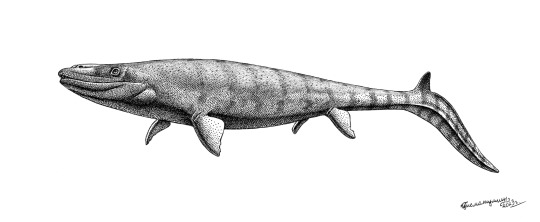
Prognathodon sp. reconstruction based on purportedly juvenile specimen with soft tissue outlines from Late Cretaceous of Jordan. This small individual was described in this paper: https://www.nature.com/articles/ncomms3423 Preserved skin impressions include silhouettes of the skin fringes of the flippers and the caudal fin. The caudal fin is quite small, but in adults it could be proportionally larger. This finding confirmed that mosasaurs converged with ichthyosaurs and metriorhynchids to develop a fish-like caudal fin.
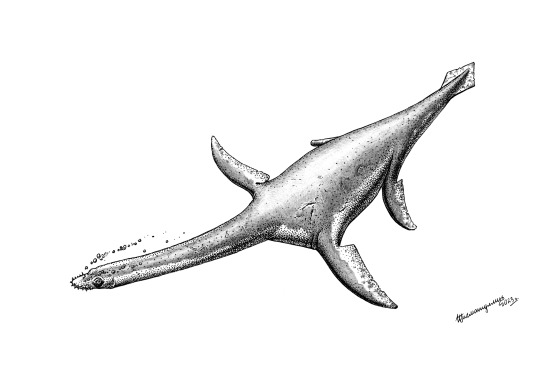
And finally, Seeleyosaurus guilelmiimperatoris (formerly species of Plesiosaurus), a microcleidid plesiosaur from Early Jurassic of Germany. Holotype of this species is almost complete specimens with some skin impressions including rhomboidal skin flap. Perhaps all plesiosaurs had caudal fins of one form or another. However, their orientation is controversial: many paleontologists are of the opinion that the fin was vertical, but others think it was horizontal.The arguments in favor of the second point of view are the rigidity of the chest, the flat and wide shape of the tail in the proximal part and the absence of bending in the distal part of the tail: https://www.researchgate.net/publication/339423536_Peculiarities_of_the_Structure_and_Locomotor_Function_of_the_Tail_in_Sauropterygia I decided to choose this version for reconstruction. Which of the scientists is closer to the truth, new findings will show. All of these drawings were done with black gel ink pen and black colored pencil with small additions of white gouache.
#dakosaurus andiniensis#dakosaurus#metriorhynchidae#thalattosuchia#prognathodon#mosasaur#seeleyosaurus#plesiosaurus#plesiosaur#sauropterygia#marine reptile#paleoart
27 notes
·
View notes
Text
Thalattosuchus and Leedsichthys
Quickly stopping by to report on a new paper describing stomach contents of a thalattosuchian (Jurassic marine crocodile).
The paper in brief describes a specimen of Metriorhynchus superciliosus (aka Thalattosuchus) with preserved stomach contents, which is already rare enough as is. What's even more interesting is that the stomach contents preserve both the gill rakes of the large fish Leedsichthys as well as various mollusc shells. Strange prey for what's a rather small piscivore. Although it was previously suggested that Metriorhynchus/Thalattosuchus attacked living Leedsichthys, this appears to have been based on missinterpreted evidence and given the enormous size difference its way more likely that the fish was simply scavenged, sorta like a kind of Jurassic whalefall. This actually finds support in the mollusc shells, which might have been ingested on accident alongside the fish remains.
Top left: The skeleton of this Thalattosuchus specimen Top right: The stomach contents in detail (G are gill rakes, S are shells) Bottom left: Live reconstriction of Thalattosuchus by Gabriel Ugueto Bottom right: Live reconstruction of Leedsichthys by @knuppitalism-with-ue
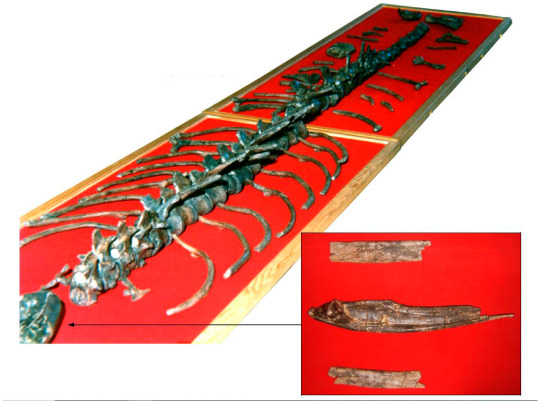
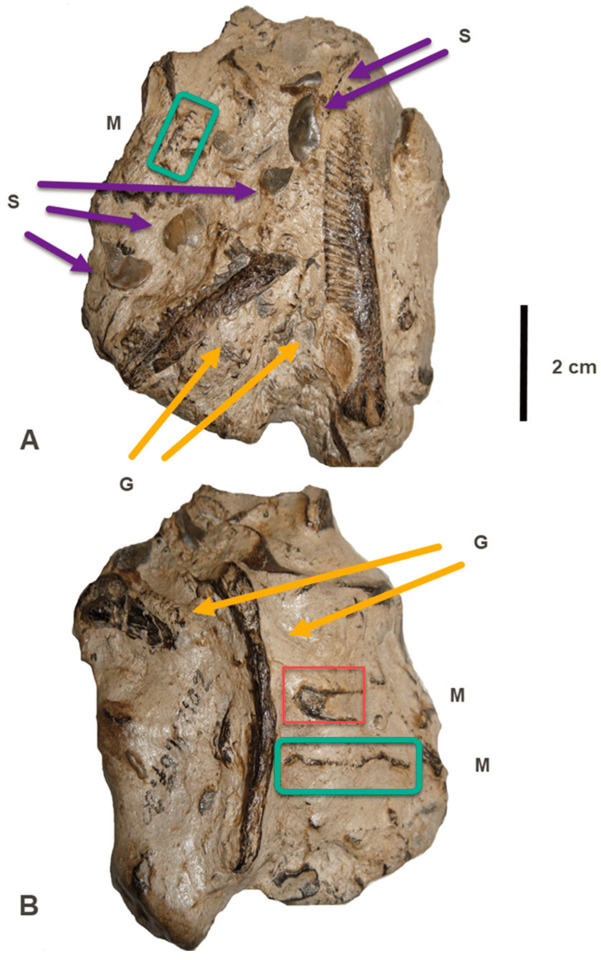

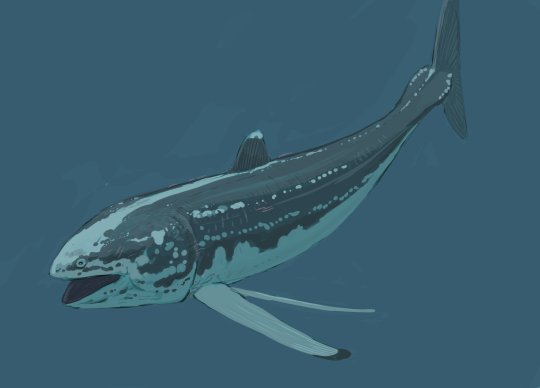
The paper itself: Fossil Studies | Free Full-Text | The Diet of Metriorhynchus (Thalattosuchia, Metriorhynchidae): Additional Discoveries and Paleoecological Implications (mdpi.com)
#thalattosuchus#thalattosuchia#metriorhynchus#metriorhynchidae#leedsichthys#palaeoblr#paleontology#prehistory#jurassic
38 notes
·
View notes
Text

A worn crocodylomorph tooth of a Dakosaurus maximus from the Kimmeridge Clay in the Wicklesham Pit in Faringdon, Oxfordshire, England. This species of marine croc was likely fully aquatic and hunted plesiosaurs and ichthyosaurs. The heavy wear seen in this tooth is due to these Jurassic fossils from the Kimmeridge Clay being reworked into the overlaying Lower Cretaceous aged Faringdon Sand.
#crocodylomorpha#fossils#paleontology#palaeontology#paleo#palaeo#dakosaurus#metriorhynchidae#thalattosuchia#jurassic#mesozoic#prehistoric#science#paleoblr#ダコサウルス#メトリオリンクス科#タラットスクス亜目#海ワニ#ワニ#化石#古生物学
18 notes
·
View notes
Text
Two more croc-line archosaurs to dig into with this one and both are super fascinating.
Obviously the star of this piece is our friend in the foreground, Plesiosuchus manselii, the largest of the fully marine metriorhynchids (the skull of which being the first one shown in the image to the right, taken from Young et al. 2012)
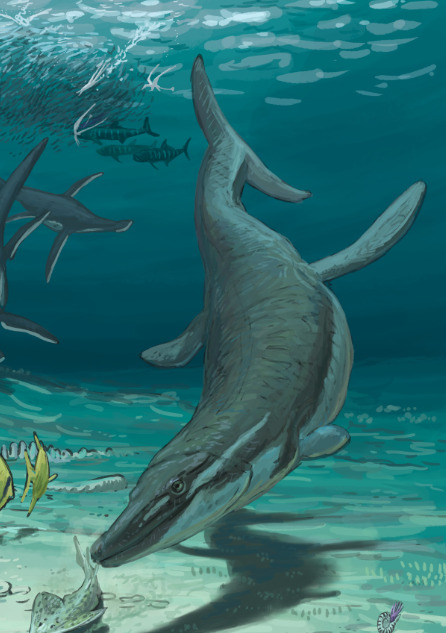
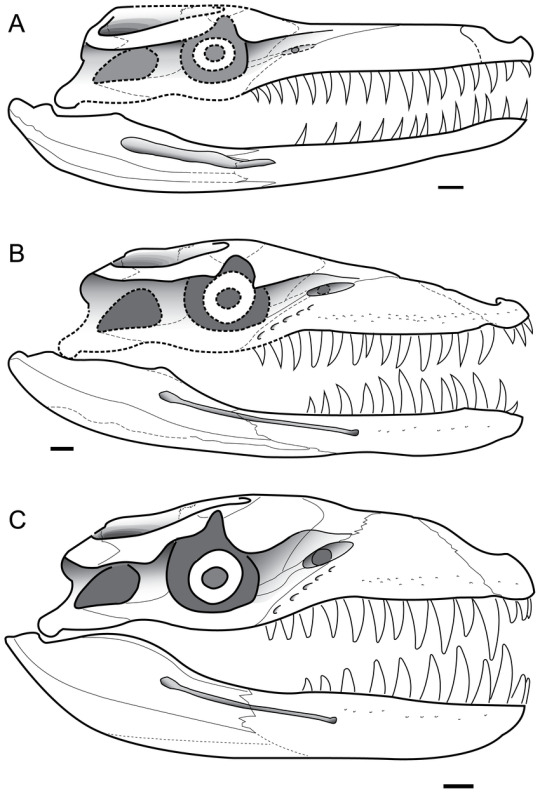
More broadly speaking, metriorhynchids are a fascinating group of early croc-relatives that stand out for having returned completely back into the water, developing a fluked tail, tiny little reduced forelimps, flipper like hindlimbs and smooth skin entirely lacking in the osteoderm armour we so strongly associate with pseudosuchians.
Plesiosuchus specifically is the largest of them. Close to 7 meters in length, it's basically in the same range as Liopleurodon (although smaller than several of the pliosaurs we know from the Kimmeridge Clay like that very decorative skeleton). Plesiosuchus actually wasn't the only metriorhynchid from the formation either. We also know of the small Cricosaurus, the name-giving Metriorhynchus and most interestingly the large-bodied Dakosaurus and Torvoneustes, which were likely to reach lengths of 4.5 to 4.7 meters respectively. At least with metriorhynchids this diversity can be explained in the different animals having very different preferences. Torvoneustes is interpreted as a durophage, feeding on hard-shelled prey. Dakosaurus is characterized by slicing dentition, potentially able to cut apart large prey with tooth wear possibly suggesting sharks or suction feeding habits. Plesiosaurus meanwhile would be able to take on large prey simply due to its great size and large gape but may have been limited by the size of its own head.
The other marine "croc" in the image is Bathysuchus, which may be described as a cousin to the metriorhynchids.


Remember Machimosaurus from the Guimarota locality that Josch drew a few weeks back? Yeah its related to that one. A teleosauroid to be precise, which are the sister group to metriorhynchoids and appear much more croc-like in their appearance despite still being a long way off from crocodiles in the strict sense. Teleosauroids may appear like what you'd think of as basal to metriorhynchoids, but they simply did their own thing after diverging, thus retaining this more ancestral bauplan with more developed limbs, more croc-like skulls and maintaining their armour plating (keep that in mind).
Bathysuchus is kind of a weird one tho. Why? Because from what we can tell Bathysuchus seems to have tried to become more like its metriorhynchoid cousins. It's known from deeper waters, its osteoderms were much more reduced and if the closely related Aelodon is anything to go from then its quite likely that this guy also started reducing the size of its forelimbs. In short, adaptations to a more pelagic lifestyle that moves away from the coastal habitat other teleosauroids seem to have preferred. Who knows, maybe its possible that in some other timeline these guys might have become something akin to metriorhynchoids like what happened with mosasaurs.
Unlike metriorhynchoids, teleosauroids were way less common in the Kimmeridge Clay, hell, to my knowledge Bathysuchus is the only one of them, a pretender among the other pelagic pseudosuchians.
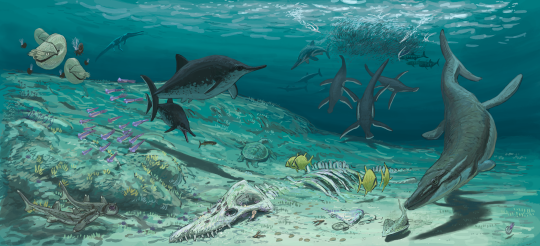
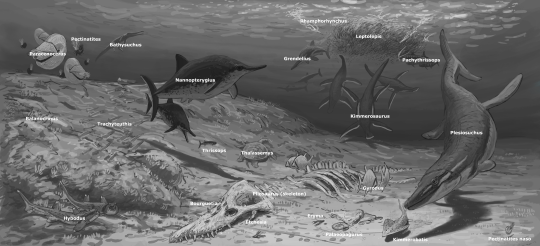
Result from the Kimmeridge Clay #paleostream!
We were only able to scratch the surface, but I think you get the idea ;)
#bathysuchus#plesiosuchus#kimmeridge clay#crocs#pseudosuchia#crocodile#metriorhynchidae#metriorhynchoidea#teleosauroidea#thalattosuchia#crocodyliform#jurassic#marine croc#paleostream#palaeoblr
598 notes
·
View notes
Text
An international team of scientists, including researchers from Germany and the UK, have described a new species of ancient marine crocodile, Enalioetes schroederi. Enalioetes lived in the shallow seas that covered much of Germany during the Cretaceous Period, approximately 135 million years ago. This ancient crocodile was a member of the family Metriorhynchidae, a remarkable group that evolved a dolphin-like body-plan. Metriorhynchids had smooth scaleless skin, flippers, and a tailfin. They fed on a variety of prey, including fast-moving animals like squids and fish, but some metriorhynchid species had large, serrated teeth suggesting they fed on other marine reptiles. Metriorhynchids are best known from the Jurassic Period, with their fossils becoming rarer in the Cretaceous. Enalioetes schroederi is known from a three-dimensional skull, making it the best-preserved metriorhynchid known from the Cretaceous.
Continue Reading.
67 notes
·
View notes
Text
Advanced Ichthyocetus - Batrachorusalkas

Usually, the rate of evolution of secondary aquatic animals is high - for example, in whales, the transition from semi-terrestrial to semi-aquatic animals took no more than 8 million years. In ichthyosaurs, this interval is reduced to 4-5 million years (from 250 to 246 million years), in mosasaurs it increases to 39-18 million years (from 125, counting from the species Kaganaias or 99, counting from the species Aigialosaurus to 86 million years ago). One can also recall seals (26 million years), metriorhynchidae (3 million years), plesiosaurs (6 million years)*... This is enough time to transform the limbs into fins and become adapted to life in the open seas.

Whale evolution. Author unknown, found in internet.
The situation becomes strange when looking at ichthyocetus, which initially retained many features for life in water and almost never went on land. The ancestor of the clade, tulerpeton, lived in the Ural Sea 365 million years ago: however, 58 million years later (!) we see quite primitive species that differ from their ancestors only in increased size and a narrower skull (as well as a specialized tail). Obviously, in addition to such forms, we must inevitably find more advanced species capable of permanent life in open waters.

Ichthyocetes - late primitive species of Ichthyocetesidae (we will use there terms as synonyms, meaning whole clade, not concrete species).
Before we proceed to their discussion, let's clarify the features of ichthyocetus. These animals are ideally adapted for shallow waters, characterized by developed limbs for movement in difficult coastal environments and a movable neck. We should immediately note that this fact makes this clade dependent on glaciation cycles, therefore, transgression and regression of the seas. As a relative of tulerpeton, ichthyostega, ichthyocetus moved on land (if the situation forced them) like seals, stretching their body with their forelimbs (while the body could not bend similarly to modern lizards or salamanders). Thus, ichthyocetes, when moving in water and land, more often use their tail and limbs, especially the front ones, while the body itself is motionless. The neck is mobile, but limited in length and mobility due to its primitiveness.
It is quite obvious to see a tendency in ichthyocetes to decrease body length and tail/fin development. Nevertheless, in all ichthyocetes, the forelimbs never became fins completely, but on the contrary, developed mobility and flexibility for - oddly enough - capturing prey. This fact is explained by the limited mobility of the skull and the diet of ichthyocetes - the search for benthos/armored mollusks. The "hands" allowed them to capture prey, while the powerful jaws crushed the shells. However, the limbs themselves are flattened due to soft tissues, and the fingers are connected by webbing. This allows them to actively use it in swimming, especially if they need to quickly get up for a new breath of air. In other cases, the tail is used for movement.

Tulerpeton and Ichthyostega found fossils
As a result of these adaptations, the most progressive group of ichthyocetes from the Early Carboniferous appears - Batrachorusalka (mermaid frogs). This group is a medium-sized nautiloid and ammonite hunter. They appear after the Serpukhov extinction, as shallow waters lost most of their species and became less productive due to a decrease in carbonate platforms (shallow waters built by reefs) and, consequently, a slowdown in speciation of species. Nevertheless, it was during this period that ammonites and natuiloids reached their heyday, and some representatives of ichthyocetes began to specialize in them, becoming batrachorusalkas. The remaining species of the clade under consideration remained in shallow waters, almost ceasing to evolve, as well as gradually reducing their range: the only thing that led to the emergence of new species was a drop in sea level and fragmentation of the original populations into smaller isolated groups.
Batrachorusalkas have reduced hind limbs, a short barrel-shaped body and a long tail convergent to those of ichthyosaurs and mosasaurs. When moving, the forelimbs stabilize the body, as well as a small "dorsal fin". The developed "hands" are capable of folding into a compact fin and are usually placed to the sides. When chasing prey, batrachorusalkas captures prey with its jaws after a high-speed pursuit, after which it stretches its "arms" forward and captures the shell of the nautiloid, after which this ichthyocetes goes into depth to dismember prey. This is done as follows: the animal crushes a part of the shell to deprive the mollusk of the opportunity to hide in its house, after which it grabs the flesh of the prey with its teeth and pulls the nautiloid's body with its forelimbs from the head, lifting them up. Then the batrachorusalka swallows the part of the prey caught in its jaws, shaking its head, and the process repeats. Since farmhands can hold air for up to an hour, they can take their time in eating food.
Batrachorusalkas have two types of teeth. The teeth on the palate and lower jaw are flat, oppressive, and concentrated in the back of the jaws. The extreme dentition, on the contrary, is cutting, convergent to the teeth of Eugeneodonts with symmetrical teeth. Another feature of the species is the nostrils, which retain their position at the tip of the muzzle: these animals have a habit of floating vertically, "like a soldier".
The decline of batrachorusalkas, which could reach a size of about 4 meters, occurred with the appearance of large eugeniodonts in the region, which surpassed marine tetrapods in speed and agility, and also hunted the same ammonoids and nautiloids better. Moreover, the edestus of the Ural Sea easily took away the caught prey from the farmhands, since the latter ate their prey too slowly. Meanwhile, the more primitive shallow-water batrachorusalkas suffered from habitat loss and competition with their more basal relatives. 310 million years ago, the last mermaid frogs became extinct. The remaining ichthyocetes die out at the end of the Carboniferous due to changes in the hydrochemistry of the coasts caused by the extinction of carboniferous forests, although some representatives (descendants of batrachorusalkas, who began to live on the northern side of the Ural Ocean and became inhabitants of mossy reefs) live to the end of the Asselian Permian, having experienced a short-term surge in speciation 294-292 million years ago due to the largest transgression of the sea in the Permian (regression finally destroys the last ichthyocetes).
So the unique amphibian dynasty and the last of the Stegocephals (Stegocephali, which does not include the ancestors of modern tetrapods) ceased to exist.
NOTES (*) The calculations are approximate and made by the author of the article. The author looked for basal representatives of the family with legs and without legs, after which he calculated the gap between these forms. They are accurate enough to give general ideas on the topic under discussion, but nothing more.
42 notes
·
View notes
Text
why doesnt anybody ever seem to talk about the extinct crocodyliform family of Metriorhynchidae that were fully aquatic and convergently evolved with mosasaurs
#rainbles#i think the only one anyone would possibly know is dakosaurus#but also i think most people just assume thats a mosasaur#at least i did until right now
6 notes
·
View notes
Text
Croc sweep. How can you not love them, metriorhynchids in particular. I mean just look at those baby hands, they are ADORABLE. @knuppitalism-with-ue for scale, photo by Sven Sachs

obviously I can't include everything. Rip to the various groups I was forced to leave out, including Mesosaurs, my beloveds.
491 notes
·
View notes
Text





Geosaurus
(temporal range: 150-136 mio. years ago)
[text from the Wikipedia article, see also link above]
Geosaurus is an extinct genus of marine crocodyliform within the family Metriorhynchidae, that lived during the Late Jurassic and the Early Cretaceous. Geosaurus was a carnivore that spent much, if not all, its life out at sea. No Geosaurus eggs or nests have been discovered, so little is known of the reptile's lifecycle, unlike other large marine reptiles of the Mesozoic, such as plesiosaurs or ichthyosaurs which are known to give birth to live young out at sea. Where Geosaurus mated, whether on land or at sea, is currently unknown. The name Geosaurus means "Mother of Giants lizard", and is derived from the Greek Ge- ("Earth", the mythical mother of the Giants) and σαῦρος -sauros ("lizard"). The name Geosaurus was established by the French naturalist Georges Cuvier in 1824.
4 notes
·
View notes
Text
A fost descoperită o nouă specie de crocodilomorf antic
În Germania, descoperirea unei noi specii de crocodilomorf, datând din Cretacicul inferior, cu aproximativ 140 până la 132 de milioane de ani în urmă, oferă o perspectivă fascinantă asupra vieții marine preistorice. Numită Enalioetes schroederi, această reptilă marina face parte din familia Metriorhynchidae, cunoscută pentru adaptările sale acvatice avansate. Acest exemplar excepțional de bine…
0 notes
Photo



It's been a while since I last showed off some of these, but here's some more commission work I've done for PBS Eons:
The metriorhynchid marine crocodilians Aggiosaurus and Cricosaurus, from "When Crocs Thrived in the Seas" https://www.youtube.com/watch?v=vgqs_9BBX10
And… what's this?

A familiar Scutellosaurus makes an appearance in a recently-published children's dinosaur book!
———
Nix Illustration | Tumblr | Twitter | Patreon
#science illustration#paleontology#paleoart#palaeoblr#pbs eons#aggiosaurus#cricosaurus#metriorhynchidae#thalattosuchia#crocodylomorpha#crocodilian#pseudosuchia#stem-croc#art#scutellosaurus#published artwork
331 notes
·
View notes
Text
In the spring of last year, I made several color reconstructions of marine reptiles for a thesis and presentation (it was about the reconstruction of marine reptiles) for a conference that was held in Ulyanovsk in September. The drawings were done in ballpoint pen (lineart) and Paint Tool Sai 2.0 (shadows and colors).

The first is reconstruction of Mixosaurus cornalianus, a widespread small Triassic ichthyosaur. I had already drawn a Mixosaurus in water earlier and even wanted to use it in the article, but later changed my mind, deciding that lateral reconstruction would better convey the appearance of soft tissues. This earlier drawing can bee seen here:

Both pieces are based on the fin impressions described in 2020 from a specimen found in the Middle Triassic rocks of the Bezano formation, Italy (www.researchgate.net/publicati…). This specimen has preserved the tissues of the dorsal and caudal fins. Both prints have thin collagen filaments, and at the base of the caudal fin, it was possible to detect the remains of smooth, scaleless skin. The fins have a triangular shape, and the dorsal one is associated with 15-23 trunk vertebrae. In other words, its position turned out to be more
forward then in reconstructions done before his paper.

The second is lateral reconstruction of the metriorhynchid Cricosaurus albersdoerferi, belonging to a widespread genus that inhabited the shallow seas of future Europe, Central America and Argentina. It was not a particularly large animal, reaching from 2 to 3.2 meters in length. Like the first reconstruction of a Cricosaurus, which I performed in the spring, this drawing is based on a specimen that preserved a large volume of soft tissue on the tail (upload.wikimedia.org/wikipedia…). Also shown here is the salt gland in the antorbital fenestra, the presence of which was previously indicated in Cricosaurus araucanensis and Dakosaurus andiniensis. The spring work with C. albersdoerferi can be seen below:
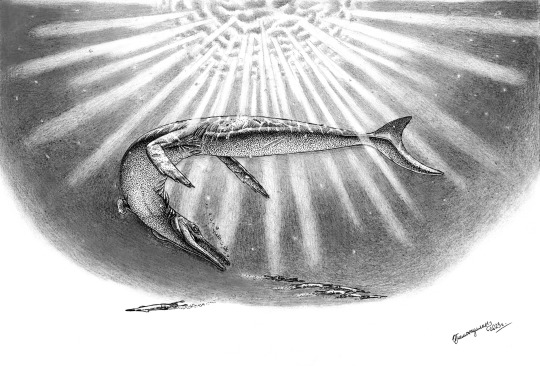

Plesiosaurs are mentioned too. This is reconstruction of the polycotylid Mauriciosaurus fernandezi from the Late Cretaceous of Mexico. A complete reptile skeleton preserved in fine-grained rocks was described by a team of paleontologists in 2017: www.researchgate.net/publicati… There are five types of soft tissue imprints around the bones. Among them are dark material, probably left from the walls of the peritoneum, dark gray traces of blubber and impressions of possible small scales. The impressions show that the animal's belly was covered with rectangular scales, which were mixed with inclusions of small fragments closer to the limbs. The scales of the living reptile were almost indistinguishable, so that the skin looked smooth. This beautifully preserved specimen showed that plesiosaurs had much more soft tissue than previously thought. The tail was especially fleshy. Fat deposits created a smooth, streamlined shape, ideal for an agile swimmer.
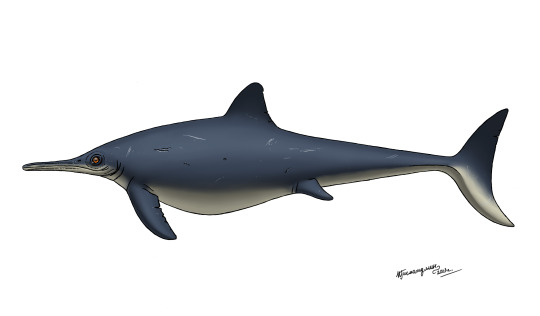
The last thesis drawing is this reconstruction of the famous Early Jurassic ichthyosaur Stenopterygius quadriscissus. Many of its skeletons of amazing preservation were found in the fine-grained limestones of Holzmaden, Germany. Some of them were discovered back in the 19th century, which made it possible to quickly correct previous ideas about ichthyosaurs. The Stenopterygius specimens retained soft tissue prints in the form of a bacterial film, which made it clear that they were fish-like creatures with a dorsal fin and a crescent tail. They re still attract the attention of researchers. In 2018, the skin structure of one partial specimen was studied: www.researchgate.net/publicati… A fossilized blubber was described, similar in microstructure to that of marine mammals and leatherback turtles. This led to the conclusion that ichthyosaurs were reptiles with a high metabolism, which required fat insulation. Blubber allowed ichthyosaurs to travel across the oceans, swimming even into the cold polar waters. In addition, this Stenopterygius had pigment cells - melanophores. They were absent on the ventral side, which means that the Stenopterygius had a dark back and a light belly. This countershading coloring is typical of today's marine vertebrates and serves as a camouflage.
I did also three works in fully traditional style, with pens and pencils, but I'll show them in the separate post. :)
#mixosaurus#stenopterygius#ichthyosaurs#cricosaurus#metriorhynchidae#mauriciosaurus#polycotylidae#plesiosaur#mesozoic marine reptiles#paleoart
31 notes
·
View notes
Text
Torvoneustes jurensis
I did mention that new croc taxa were numerous this week. After covering both Triassic forms, here's the newest crocodyliform from the Jurassic. Torvoneustes jurensis, a large (4 meter) metriorhynchid.
Artwork by SDSO, figure from Girard et al. 2023


Now the genus Torvoneustes itself isn't a new one. The genus itself has been knocking around since 2010 whereas one species has been known since 1910. Fossils of this genus have previously been found in the UK, Czech Republic and even Mexico. This species tho is brand new tho, found in the Jura Mountains of Switzerland in 2008. The fossils date to the Kimmeridgian, the second to last stage of the Jurassic.
Like its relatives, Torvoneustes jurensis was an animal well adapted for life in the open ocean. The eyes faced sideways, the limbs were converted into flippers (with especially short arms), the tail had a fin more like that of a shark than the paddle of a crocodile. And it was smooth, lacking the osteoderm armor we so often associate with pseudosuchians. It reached a length of up to 4 meters, which puts it among the larger metriorhynchids alongside Suchodus (4.1), Dakosaurus andiniensis (4.3) and Torvoneustes carpenteri (4-4.7).
Artwork below by Dmitry Bogdanov

Being recovered as one of the most derived members of its genus, Torvoneustes jurensis is interesting as it allows to further observe the evolutionary trends undergone by this lineage. For example, the skull bones appear to have become increasingly smoother, possibly to be more hydrodynamic or because basking becomes less important. The oldest species also lacks the pseudoziphodont teeth seen in all others, but its possible that this was just lost in one form and retained by all others. There's also some straight up contradictions presented by T. jurensis relative to other species. For example, previously it was thought that species in the genus became increasingly durophagous, taking on harder shelled prey and thus developing less curved, more robust teeth. This does however not seem to be the case for this new species, which could have been more of a generalist. It also retains more teeth than other derived species of Torvoneustes, another trend seemingly debunked by this new find (tho toothcount was so far limited by available material, so this may change still if we find better fossils of the other species).

Overall its another really interesting find and while not a new genus, its still nice to see further exploration of the species diversity among crocodyliforms
#palaeoblr#prehistory#jurassic#croc#pseudosuchia#thalattosuchia#metriorhynchidae#geosaurinae#ocean croc#marine reptile#paleontology#paleontology news
57 notes
·
View notes
Photo
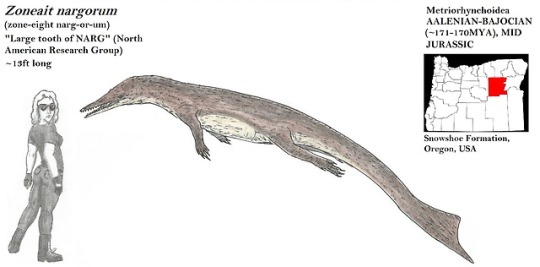
The first ever restoration of this genus so far as I know. Zoneait is the oldest known metriorhynchoid, though not the most basal, as it is more derived than Eoneustes and Teleidosaurus. Described in 2015, Zoneait showed palaeontologists how metriorhynchoids evolved; as the humerus was more than twice as long as the ulna, it showed how these would eventually be shortened into fins. Zoneait also shows other basal features, as the digits have not fused together into fins as yet, but shows more derived features as well; eyes aligned on the side of the head rather than towards the top, and the presence of salt glands. References: -en.wikipedia.org -"A new metriorhynchoid (Crocodylomorpha, Thalattosuchia) from the Middle Jurassic of Oregon and the evolutionary timing of marine adaptations in thalattosuchian crocodylomorphs", Eric Wilberg. (http://www.mediafire.com/file/dyb44g6ypzbbtd8/A_new_metriorhynchoid_%28Crocodylomorpha%2C_Thalattosuchia%29_from_the_Middle_Jurassic_of_Oregon.pdf) -Skeletal mounts of Metriorhynchus and other forms for reference towards the back half
#zoneait#metriorhynchoidea#metriorhynchus#metriorhynchidae#thalattosuchia#crocodiles#crurotarsi#archosaurs#archosauromorpha#paleoart#paleo#paleoblr#palaeoblr#jurassic#aalenian#oregon#usa#midjurassic#middle jurassic#bajocian
15 notes
·
View notes
Note
What do you think of Herrera et. al's 2015 paper on possible Metriorhynchid oviviparity? :)
I think the logic is pretty sound! Can't go on land, therefore can't lay eggs, and the sacral region of these animals is kinda weird in a probably-gives-live-birth way! It's a cool paper, really like it!
Here's the paper if other people want to read it! https://www.cambridge.org/core/journals/earth-and-environmental-science-transactions-of-royal-society-of-edinburgh/article/morphology-of-the-sacral-region-and-reproductive-strategies-of-metriorhynchidae-a-counterinductive-approach/AE3A4183C5925CFE4F6F3108B3B2C147
Also as this is my dragon blog I'll mention that my sea dragons have similar logic and also have live births instead of laying eggs - not certain my dragons will look like metriorhynchoids because I'm still trying to match myths to my dragon designs, but due to my line of work I'll be borrowing bits of thalattosuchian science to describe them :}
4 notes
·
View notes